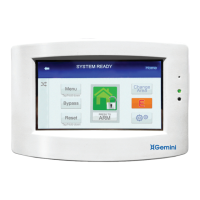GEM-TOUCH K Style Keypad Operating Guide
25
the central station of a fire, auxiliary,
or police emergency (also audible
within the premises). See page 10.
Partitioned System - A system that has
been subdivided into independent
subsystems (called "Areas"). Up to 8
Areas permitted.
Priority Arming - When attempting to
arm the system with a faulted zone, a 3
-second tone will sound and the
TROUBLE icon will appear, indicating
that the zones must be secured before
the system can be armed.
Report - A transmission to a central
station notifying of a change in the
status of the system (alarm, trouble,
low battery, etc.).
RF Low Battery - (Wireless systems
only) Weak transmitter battery.
RF Supervisory - (Wireless systems
only) Periodic test report from a
transmitter (if a report is not received
on time, a supervisory-failure system
trouble will result).
Ringback - A beep after arming verifying
the central-station's receipt of a
closing ("arming") report.
Service / Maid Code - A User Code
intended for temporary use.
Sounder - A local warning device at
each keypad to alert that (a) entry
delay has started; (b) an attempt was
made to arm with a zone in trouble;
(c) a Day-Zone condition exists (see
Zones: Day Zone); (d) 10 seconds
exit time remaining; (e) invalid code
entered; or (f) central station-
acknowledged arming (see
Ringback).
System Trouble - A problem (low
battery, power failure, etc.) detected
in the system.
Trouble - A zone fault. For example, an
open door, window, or other problem
that may prevent arming.
User Code - Your personalized code for
arming and disarming the system.
Used also for entering System Set-
tings. It may contain up to six digits.
Zones - Independent circuits that protect
specific parts of the premises, such
as:
• Auto-Bypass Zone: A zone that will
be automatically bypassed from the
protection system if it is in trouble
(faulty) when the system is armed.
• Burglary Zone: Detects intrusion.
• Exit/Entry Follower Zone: Provides
exit and entry delay for interior
devices. Entry delay only occurs if re-
entry takes place through the normal
exit/entry door first.
• Fire Zone: Detects fire alarms or
trouble conditions.
• Interior Zones: Circuits within the
premises, usually including space-
protection devices, interior doors, etc.;
but not exterior doors or windows.
(Two groups of Interior Zones may be
programmed for each Area).
• Selective-Bypassed Zone: A zone
that can be individually bypassed by
tapping Bypass followed by the zone
number.
• 24-Hour Zone: A zone that is armed
and ready at all times to respond to
an emergency situation.
GL OS S ARY

